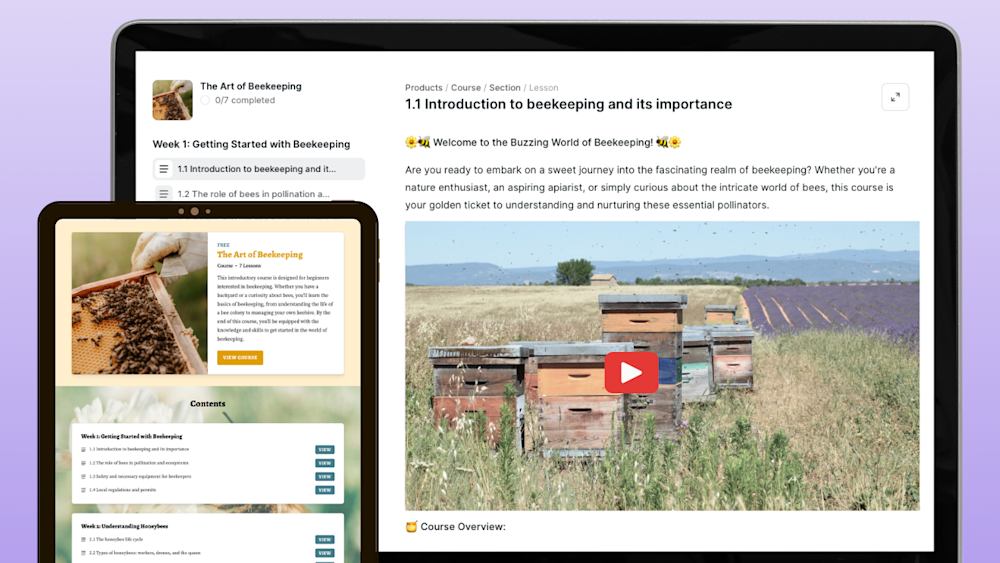Building your course content is a beast of burden.
Let alone recording it.
You need audio-recording gear to pump out polished online classes with high-quality audio, and you know this. The same is true for live webinars and tutorials. A good microphone can make or break your info products.
It can also do the same for your bank balance.
To save you from hours of hunting through Amazon reviews and scouring the internet to find the best microphones, we’ve done the homework for you.
Today, we’ll walk you through different types of microphones, the top models and brands on the market, and when to use them.
There’s an option here that’s right for any online teacher or leader.
Before we dig into models though, let’s briefly cover some microphone basics, so you have a better understanding of what to look for.
Some basics about the best microphone setup for online courses and webinars
All but one of our recommendations include a cabled microphone setup.
Why? The market and listeners prefer the sound quality of cabled microphones.
Wireless microphones have a retail sales value of $172 million, a far cry from the $455 million retail sales value of cabled microphones.

Another way we categorize our best microphone choices is by two cable types — XLR mics and USB mics.
Here’s a quick visual difference between the two:

XLR pro:
The advantage of an XLR cable is it’s the industry standard, which means most pro audio recording gear is designed for XLR microphones. This gives you more options and sound control (think pro musicians and podcasters).
XLR con:
With XLRs, you need to plug it into an audio interface that converts the analog to something digital — a.k.a. playable on your Mac or PC. Although, an XLR to USB adapter is an option if you’re not looking to gain phantom power or ultimate sound control.
USB pro:
The advantage of using a USB mic is you can plug it right into your computer or laptop, which means you don’t need extra audio equipment.
USB con:
While it offers a convenient connectivity to your computer’s USB port, you don’t have as much nitty-gritty control over the sound quality.
Since most online courses and webinars involve plugging into a computer at some point, most of our choices are USB microphones.
Lastly, we break up our first category of XLR mics into dynamic microphones and condenser microphones.

Dynamic microphones use passive listening and are designed to drown out background noise.
If you work in a space that has ambient noise, and you need crystal clear high-quality audio, dynamic mics may be ideal. Again, great for pro-musician and pro-podcaster audio quality.
Condenser microphones, on the other hand, use active listening and pick up sounds with tons of detail and accuracy. These are great for studio-type environments that don’t have a lot of ambient noise or background noise.
In a nutshell:
When recommending our mic setup for your online course or webinar, generally speaking, you should be able to produce good quality audio with these microphone category choices:
-
Wired
-
USB
-
Condenser
That being said, we want to give every online entrepreneur a solid option (including pro-level audio recorders, musicians, filmmakers, podcasters, et cetera), so we expand a bit beyond those options.
But OK. Now, let’s find the right microphone setup for you.
XLR dynamic and condenser microphones
Editor’s Note: All prices are valid at time of writing. Hopefully, if you find they’re different, they’re lower, but if not, there should be plenty of options to choose from in this list.
Zoom DZM-1 dynamic microphone

The Zoom DZM-1 dynamic microphone includes an internal shock mount which means that it can isolate sound from bumps and extraneous unwanted noise.
The stand mount makes it super easy to put on a mic stand, although that is an extra accessory you’ll need to purchase separately if you don’t have one. You don’t, however, need to purchase an external shock mount, as this mic comes with an internal shock mount.
This mic also captures a smooth, broadcast-quality sound from its large-diaphragm dynamic design.
Price: $59.99
Connectivity: Wired XLR
Polar pattern: Unidirectional cardioid pickup pattern
Frequency response: 50Hz to 20kHz
Best microphone for: Online teachers that want to capture loud, strong sounds with a competitively priced mic. Ideal for live online teaching or high-quality audio recording of instruments and voice.
Shure SM7B cardioid dynamic microphone

For a fancier option, check out Shure’s SM7B cardioid dynamic microphone. It’s a top-notch pro-quality mic that’s designed for musicians, singers, and creators who are serious about their audio recording quality.
The flat, wide-range frequency response is ideal for exceptionally clean and natural reproduction of music and speech.
Shure’s SM7B comes with an internal “air suspension” shock isolation that eliminates mechanical noise transmission (like from your computer).
It also has a built-in pop filter, so you don’t need to add external accessories to control the sound. Of course, the XLR connectivity gives you more flexibility and options for controlling your sound to be exactly what you want.
Price: $399
Connectivity: Wired XLR
Polar pattern: Unidirectional cardioid pickup pattern
Frequency response: 50Hz to 20kHz
Best microphone for: Serious audio recording, pro musicians, or online teachers who want crystal clear pro-quality sound and have the cash surplus to achieve it.
Sidenote: The XLR + USB version of this is Shure’s MV7 USB dynamic microphone, which goes for $249.
AKG P120 condenser microphone

The AKG P120 is a high-performance vocal condenser microphone that’s great for general purpose voice recording and presenting.
This microphone works well for both live and prerecorded webinars, tutorials, and online course lessons.
If you’re looking for a mic setup that can serve a range of general online course and webinar purposes — from recording musical instruments to presenting voice-over slide decks — this one will give you high-quality audio.
Price: $79
Connectivity: Wired XLR
Polar pattern: Unidirectional cardioid pickup pattern
Frequency response: 20Hz to 20kHz
Best microphone for: Online teachers who want to use a competitively priced XLR condenser mic setup for presenting live and prerecorded tutorials with high-quality audio from a desktop.
By the way, if you’re looking for additional accessories for your XLR mics, like this accessories bundle, which includes a mic shock mount and pop filter, you can grab a kit for a very reasonable price.

This particular set goes for $14.99, for example, and fits a 46mm-53mm microphone diameter.
If your mic doesn’t have built-in features, you can find similar shock mount and pop filter accessory packages for your specific microphone (just be sure to check the compatibility).
Speaking of mic accessories, with the XLR mics, you’ll need to figure out how to deliver your audio content in digital format inside your online course or webinar, which means audio editing software for audio recordings, or an XLR to USB adapter for live tutorials.
To avoid the extra tech setup altogether, USB mics are ideal — especially if pro-audio recording status is not your highest priority.
USB condenser microphones
Blue Yeti condenser microphone

Blue Yeti condenser microphone is a top-tier mic that plugs directly into a USB port. It’s considered one of the best microphones because of its versatile pattern modes.
Its proprietary tri-capsule technology lets you choose from four pattern modes: cardioid, steroid, omnidirectional, and bidirectional modes.
Aside from pattern selection, the Yeti mic also comes with studio controls for headphone volume control, instant mute, and microphone gain.
The flexibility in audio controls lets you present and record high-quality audio, which makes it a great option for creators who want to monetize their music or plug great audio quality directly into their computer.
Price: $129.99
Connectivity: Wired USB
Polar pattern: Multipattern
Frequency response: 20Hz to 20kHz
Best microphone for: Online teaching content that highlights high-quality audio content with the convenience of plugging straight into the computer from a desk or studio setting. An audio course, for instance, can really benefit from this microphone.
Blue Snowball iCE USB condenser microphone

Another plug-and-play USB microphone is the Blue Snowball iCE condenser microphone. It comes with an attached adjustable stand that makes it very easy to move around and set up on any desk.
The size is compact and portable, and the connectivity is a simple USB output that you can plug directly into your computer.
The Blue Snowball iCE gives you clear audio quality for live online teaching, using platforms like Skype, Zoom, or YouTube Live. Podcasters are known to use this model, which means it’s also a great option for prerecording your webinars and online course content.
Price: $49
Connectivity: Wired USB
Polar pattern: Unidirectional cardioid pickup pattern
Frequency response: 40Hz to 18kHz
Best microphone for: Online teachers who want a portable desktop option that’s competitively priced and convenient to use in and outside your office or studio. You won’t get the best quality ever, but you’ll land firmly in the “good” square.
SUDOTACK USB condenser microphone kit

SUDOTACK’s USB streaming podcast PC microphone is a solid condenser microphone that provides high-quality audio using USB connectivity.
This one comes in a kit, so if you’re looking for a good quality mic setup that comes in one bundle, this may be the way to go.
The SUDOTACK USB mic kit includes a microphone stand, shock mount, table clamp, anti-wind foam cap, USB A to B cable, and a pop filter.
Price: $52.99
Connectivity: Wired USB
Polar pattern: Unidirectional cardioid pickup pattern
Frequency response: 30Hz to 16kHz
Best microphone for: Creators who are just starting out. If you’re looking for a good quality microphone kit that provides high-quality audio for a competitive price, this is a full kit that will give you just that.
On the other end of the spectrum, you may not want to deal with any audio recording equipment. A headset with a good quality mic may be all that you need.
Logitech USB headset H390

The Logitech USB headset H390 is a hands-free headset with a noise-canceling microphone attached. You can plug the headset directly into your computer or laptop’s USB port.
If you’re conducting live classes, just plug the headphones into your computer and start presenting. When you’re not teaching or conversing, you can move the left-sided mic boom, so it’s tucked out of the way.
Price: $24.99
Connectivity: Wired USB
Polar pattern: Unidirectional
Frequency response: 100Hz to 10kHz
Best microphone for: Online teachers who want minimal audio setup. Ideal for non-techie creators who want good quality audio for simple online tutorials or presenting voice-over slide decks.
While we’re on the topic of portability and tech-free simplicity, there’s a desktop version of the headset setup but without the head gear.
JOUNIVO USB portable desktop condenser microphone

JOUNIVO USB desktop microphone is a very portable USB mic that can easily travel with you to any desktop setting.
Its tall and slender gooseneck design makes it super compact and simple to move and adjust. There’s also a mute button and LED indicator on the small stand that tells you the working status.
With this desktop mic being the lowest-priced mic on our list, it’s worth a try if you’re an avid traveler or someone who likes to change teaching and working environments frequently.
Note that there’s no volume control, and the frequency response is not highlighted on its product page (which makes sense given the price point).
Price: $14.99
Connectivity: Wired USB
Polar pattern: Omnidirectional
Best microphone for: Beginner online teachers on-the-go who want a portable, very compact USB microphone that easily packs up with their laptop gear. Ideal for live online teaching rather than recording high-quality audio, although it’s decent for very basic voice-over recording.
Of course, sometimes you need your online teaching to be completely wireless — like instructors who have an online physical therapy clientele or online fitness business.
We have options for that, too.
Non-desktop microphone setup
Rode SmartLaV+ lavalier condenser microphone

Rode’s SmartLav+ is a great portable hands-free mic option for online teachers who move around a lot while instructing.
For instance, a fitness instructor can clip on the lapel and plug the jack straight into a portable recording device or mobile device.
Or if you’re someone who teaches using a whiteboard or other props, or someone who teaches as a talking head (a.k.a. directly facing the camera), this is a solid option and pairs well with an external audio recorder.
Price: $79
Connectivity: Wired TRRS jack
Polar pattern: Omnidirectional
Best microphone for: Online teachers who use a lot of movement while teaching, or teach and record in the field, and want a hands-free microphone that easily plugs into their mobile or external recording device. Also ideal for face-to-camera video recording.
By the way, while it’s entirely possible to record professional-quality video straight from your iPhone, you can beef up your audio quality by going one step beyond your everyday Apple products.
Plug your lavalier or headset mic into something fancier than your mobile device for better audio and volume control, like an external audio recorder.
Zoom H2n recorder

The lavalier can easily plug into the portable Zoom H2n recorder, which can run for over 20 hours using only two standard AA batteries.
As for sound file capacity, the Zoom records up to 24-bit/96kHz in WAV files and up to 320kbps for MP3 format. The audio recordings are stored directly to SD and SDHC cards up to 32GB.
If you don’t want to use a wireless lavalier, you can record directly into the Zoom’s five built-in microphones using four recording modes: mid-side stereo, X/Y stereo, and 2-channel and 4-channel surround.
In case you’re interested, here’s a visual of what those mic configurations look like:

As for the other pertinent details:
Price: $169.99
Best microphone for: A portable non-desktop mic option that offers plenty of sound control for audio recording.
Looking for a combo lavalier + mic option? Check out our final mic system.
Rode Wireless Go wireless microphone system

The Rode Wireless Go setup works in the same way that a lavalier and external recorder does, only more compact.
The system comes with a compact wireless microphone that comes with earbuds and a transmitter and receiver.
You can clip on the wireless transmitter and use it as a super small belt-pack transmitter for a lavalier microphone. Or you can use its built-in omnidirectional condenser capsule as a wireless mic itself.
The receiver is equally as compact and can even mount on a camera or GoPro.
It also comes with a small TRS coiled cable for compatibility with DSLRs.
Price: $199
Connectivity: Wireless USB
Polar pattern: Omnidirectional
Best microphone for: Physically active creators and online teachers who move around a lot while instructing and want a portable wireless system.
Present your online class with the best microphone setup and audio quality for your content
Like with anything in your business, choose the option that works best for your purpose and budget.
Here’s the breakdown of the best microphones for your online courses and webinars:
XLR mics (dynamic and condenser)
-
Use Zoom’s DZM-1 dynamic mic if you want high-quality isolating audio; price is $59.99.
-
Use the Shure SM7B dynamic mic if you want a top-notch cardioid pickup for serious audio pros; price is $399.
-
Use AKG’s P120 condenser mic for general use and high-quality audio; price is $79.
USB mics (condenser)
-
Use the Blue Yeti condenser mic for a top-tier USB mic with multipattern modes; price is $129.99.
-
Use the Blue Snowball iCE USB condenser mic for a high-quality portable desktop mic; price is $49.
-
Use SUDOTACK’s USB condenser kit for a beginner package with accessories; price is $52.99.
-
Use Logitech H390 USB headset for minimal audio gear and simple live tutorials; price is $24.99.
-
Use JOUNIVO’s USB portable mic for a compact desktop mic for simple live tutorials; price is $14.99.
Non-desktop mics
-
Use Rode’s SmartLaV+ lavalier condenser mic to plug into your mobile device or other recording device; price is $79.
-
Use the Zoom H2n recorder for high-quality audio recording that gives you more sound control than your mobile device; price is $169.
-
Use Rode’s Wireless Go mic system for a compact wireless transmitter and receiver kit that records good quality audio; price is $199.
We hope our researched, streamlined list of the best microphones for online courses and webinars shaves hours off your shopping time.



